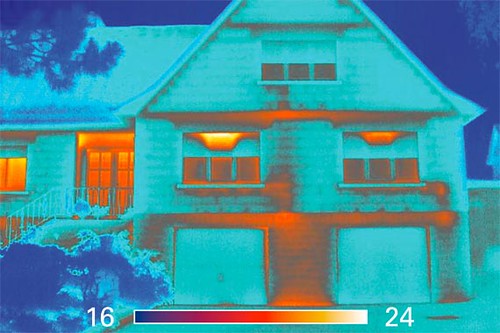##Applications##
There are two primary types of environmental investigations that are driving the development of DIY thermal imaging tools and methods: a "heat-busters" program in East Harlem, and a near-forensic-level water quality monitoring program in the Gowanus Canal.
##Approaches##
There are three prototypes in development:
* a RGB LED flashlight with a non-contact infrared sensor that "paints" the temperature of the surface directly on the wall for capture with a second timelapse camera.
* a thermometer for draggling through the water, taking contact measurements mapped to a RGB light, also for capture with a second timelapse camera.
* a [scanning thermal camera](/wiki/scanning-thermal-camera) on a lego turntable (software also in development) that sweeps back and forth across a scene, recording the temperature variation to build up an image that looks like this:
 ##Thermal Flashlight##
The first approach results in a kind of "light painting" -- a color heatmap overlaid directly onto the scene. This is the simplest, cheapest, and to date, most effective way we have developed of measuring heat leaks or cool leaks indoors and outdoors.
These research notes will be integrated into this page to provide instructions on building and using your own thermal flashlight:
* http://publiclaboratory.org/notes/ad/11-28-2011/thermal-camera-arduino-uno-mlx90614-ir-thermometer
* http://publiclaboratory.org/notes/warren/12-12-2011/circuit-diagram-simple-thermal-flashlight
Several meetups have been organized to build and test thermal flashlights, at RISD (Providence, RI) and in Brooklyn, NY. We are organizing one now in Somerville, MA:
* [Thermal Flashlight workshop](/wiki/thermal-flashlight-workshop)
##Thermal Flashlight##
The first approach results in a kind of "light painting" -- a color heatmap overlaid directly onto the scene. This is the simplest, cheapest, and to date, most effective way we have developed of measuring heat leaks or cool leaks indoors and outdoors.
These research notes will be integrated into this page to provide instructions on building and using your own thermal flashlight:
* http://publiclaboratory.org/notes/ad/11-28-2011/thermal-camera-arduino-uno-mlx90614-ir-thermometer
* http://publiclaboratory.org/notes/warren/12-12-2011/circuit-diagram-simple-thermal-flashlight
Several meetups have been organized to build and test thermal flashlights, at RISD (Providence, RI) and in Brooklyn, NY. We are organizing one now in Somerville, MA:
* [Thermal Flashlight workshop](/wiki/thermal-flashlight-workshop)

 ##Thermal Flashlight##
The first approach results in a kind of "light painting" -- a color heatmap overlaid directly onto the scene. This is the simplest, cheapest, and to date, most effective way we have developed of measuring heat leaks or cool leaks indoors and outdoors.
These research notes will be integrated into this page to provide instructions on building and using your own thermal flashlight:
* http://publiclaboratory.org/notes/ad/11-28-2011/thermal-camera-arduino-uno-mlx90614-ir-thermometer
* http://publiclaboratory.org/notes/warren/12-12-2011/circuit-diagram-simple-thermal-flashlight
Several meetups have been organized to build and test thermal flashlights, at RISD (Providence, RI) and in Brooklyn, NY. We are organizing one now in Somerville, MA:
* [Thermal Flashlight workshop](/wiki/thermal-flashlight-workshop)
##Thermal Flashlight##
The first approach results in a kind of "light painting" -- a color heatmap overlaid directly onto the scene. This is the simplest, cheapest, and to date, most effective way we have developed of measuring heat leaks or cool leaks indoors and outdoors.
These research notes will be integrated into this page to provide instructions on building and using your own thermal flashlight:
* http://publiclaboratory.org/notes/ad/11-28-2011/thermal-camera-arduino-uno-mlx90614-ir-thermometer
* http://publiclaboratory.org/notes/warren/12-12-2011/circuit-diagram-simple-thermal-flashlight
Several meetups have been organized to build and test thermal flashlights, at RISD (Providence, RI) and in Brooklyn, NY. We are organizing one now in Somerville, MA:
* [Thermal Flashlight workshop](/wiki/thermal-flashlight-workshop)
